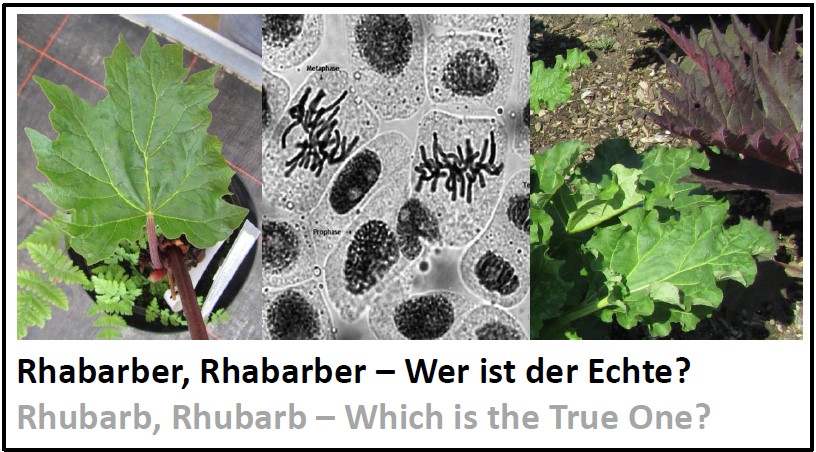 Plant Evolution 2023
Plant Evolution 2023
The Rhubarbs are a very young genus that has been born only around 6 million years ago, when the Tibetian plateau was formed. They have a long tradition in Traditional Chinese Medicine (TCM) and are also commercialised in Europe as phytopharmaceutica. However, the Chinese tradition distinguishes two types of medicinal Rhubarb, for good reasons. The so called Ta-Huang is used to cure gastrointestinal diseases and contains emodin as active compound. Instead, T’u Ta-Huang is not used for this purpose, because it contains rhaponticin, which acts as a phytoestrogene. However, this type of Rhubarb has potential to alleviate difficulties in the female menopause. Unfortunately, the nomenclature of Rhubarbs is a complete mess, and the market is flooded with wrongly declared products. Using genetic barcoding, we have tried to sort this out. It turns out that some "species" such as Rheum officinalis, are not a real species, but derive from different origins. On the other hand, the true Rheum rhaponticum, which is interesting as source for rhaponticine, cannot be clearly delineated from Rheum rhabarbarum, which is widely used for food purposes. These two species are overlapping, because Rheum rhabarbarum originated from R. rhaponticum by allopolyploidy, which means, it has twice the numbrer of chromosomes. Thus, the project explores the possibility to discern the two species by karyocytology - meristematic cells in the root tip are prepared to visualised the chromosomes, such that in the metaphase plate the ploidy can be explored. Moreover, using our Rhubarb collection, the potential parent of R. rhabarbarum is assessed (plastidic markers are only inherited from the mother). Manuscript with figures on Rhubarb identification (unpublished) is deposited on Ilias. Wober et al. 2007 on the mode of action of rhaponticine.
Genetic Barcoding
Wie gehen wir vor?
Zunächst investieren wir viel Aufwand in die Echtheit unserer Belegpflanzen, die wir im Botanischen Garten kultivieren und die wir mithilfe klassischer Bestimmung authentifizieren. Die Qualität einer Methode steht und fällt mit der Echtheit der Referenzpflanze. Daher tragen alle unseren Pflanzen einen Erkennungscode, der sich nie ändert, auch wenn sich der Name einer Pflanze ändert (das kommt nicht so selten vor - erstens wird die Taxonomie der Pflanzen immer wieder reformiert, wodurch sich auch Namen ändern, zweitens sind geschätzte 10-20% der Pflanzen in Botanischen Gärten oder Genbanken falsch bestimmt oder benannt, so dass sich oft Pflanzen, die wir von anderen Gärten bekommen, sich nach unserer Bestimmung als etwas anderes herausstellen). Im zweiten Schritt wird dann eine Datenbankanalyse nach vorhandenen genetische barcodes durchgeführt - je mehr Vergleichsmarker es gibt und je informativer die sind, umso eindeutiger werden die Ergebnisse sein. Es wird dann genomische DNS isoliert und dann werden die passenden barcoding marker über PCR amplifiziert und zum Sequenzieren geschickt. Parallel werden die Akzessionen mikroskopisch verglichen, interessante diagnostische Marker sind zum Beispiel Spaltöffnungsmuster oder die relative Größe Epidermiszellen / Palisadenparenchym, aber auch Haare, Trichome, Kristalle. Wenn die Sequenzen geliefert werden, werden diese mit Sequenzen aus den Datenbanken aliniert und daraus ein NJ-Baum erstellt. Dann werden geeignete Sequenzunterschiede ausgesucht, um daraus einen diagnostischen Test zu entwickeln - hierfür kommen neben RFLP vor allem ARMS in Frage.
Beispiele
- Projekt Bambus als Novel Food. mehr...
- Projekt Tödlicher Bärlauch. mehr...
- Projekt TCM-Gojibeere. mehr...
- Projekt TCM-Allium fistulosum. mehr...
Publikationen
169. Ríos Rodríguez D, Sahi VP, Nick P (2021) Authentication of Holy Basil using Markers Relating to a Toxicology-Relevant Compound. Eur Food Res Technol 247, 2485-2497 - pdf
[50] Ichim MC, Häser A, Nick P (2020) Microscopic Authentication of Commercial Herbal Products in the Globalized Market: Potential and Limitations. Front Pharmacol 11, 876 - pdf
140. Wetters S, Nick P, Horn T (2018) Goji Who? Morphological and DNA based Authentication of a „Superfood”. Frontiers Plant Science 9, 1859 - pdf
[44] Nick P (2018) Pflanzliche „Superfoods“ – Verbraucherschutz versus Globalisierung. Lebensmittel und Recht 6, 228-232 - pdf
138. Jürges J, Sahi V, Rios D, Reich E, Bhamra S, Howard C, Slater A, Nick P (2018) Product Authenticity versus Globalisation - The Tulsi Case. PloS ONE 13, e0207763 - pdf
102. Horn T, Völker J, Rühle M, Häser A, Jürges G, Nick P (2014) Genetic authentication by RFLP versus ARMS? The case of Moldavian Dragonhead (Dracocephalum moldavica L.). Eur Food Sci Technol 238, 93-104 - pdf
90. Horn T, Barth A, Rühle M, Häser A, Jürges G, Nick P (2012) Molecular Diagnostics of Lemon Myrtle (Backhousia citriodora versus Leptospermum citratum). Eur Food Res Technol 234, 853-861 - pdf
